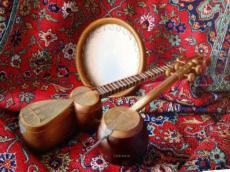|
|
TODAY.AZ / Arts & Entertainment
Mugham unites music enthusiasts around globe
26 August 2024 [17:57] - TODAY.AZ

Laman Ismayilova
Being one of the oldest musical styles in the East, mugham music never ceases to amaze music enthusiasts around the globe, serving as a major element in uniting people.
The mugham contains seven main modes - Rast, Shur, Segah (are especially common), Shushtar, Bayaty-Shiraz, Chahargah, Humayun, and three collateral kinds - Shahnaz, Sarendj, and Chaargah in some other form.
August 26 is recognized as the International Day of Azerbaijani Mugham as well as the celebration of music from the countries along the Silk Road.
In 2010, the decision made by the mayor’s office of Niagara, Canada, and the management of the Niagara International Chamber Music Festival reaffirmed the global significance of mugham music, a national treasure of Azerbaijan.
The day holds a special place for music enthusiasts both in Azerbaijan and abroad.
First Vice-President of Azerbaijan Mehriban Aliyeva has played a major role in promoting mugham art worldwide.
Thanks to the efforts of the First Vice-President, UNESCO proclaimed Azerbaijani Mugham a "Masterpiece of the Oral and Intangible Heritage of Humanity" (2008). The Mugham art entered the UNESCO Intangible Cultural Heritage List in 2008.
At the initiative of the Heydar Aliyev Foundation, the International World of Mugham Festival was held in the country for the first time in 2009. Music experts from other countries took part in a symposium held along the festival.
Since the 20th century, mugham has gained wide recognition in the global cultural arena.
Azerbaijan's prominent composers used mugham in their music pieces.
Fikrat Amirov pioneered the symphonic mugham genre with three symphonic mugams - "Shur", "Kurd-Ovshary" in 1948, and "Gulustan Bayati-Shiraz" in 1971.
Uzeyir Hajibayli composed the opera "Leyli and Majnun" based on mugham.
URL: http://www.today.az/news/entertainment/252169.html
 Print version
Print version
Connect with us. Get latest news and updates.
See Also
- 08 April 2025 [14:57]
Training for library staff to be held in Ganja - 08 April 2025 [13:24]
Garabagh University aims to become hub for education and innovation - 08 April 2025 [13:07]
Exhibition "Second Life" to open at Carpet Museum - 08 April 2025 [12:35]
Baku to host Qatar Culture Days - 07 April 2025 [13:37]
Azerbaijan honors 119 years of Molla Nasreddin satirical magazine - 07 April 2025 [13:00]
Ganja to hold series of cultural events - 04 April 2025 [15:57]
President Ilham Aliyev signs order to mark 190th anniversary of Seyid Azim Shirvani - 04 April 2025 [15:38]
Baku to host concert dedicated to renown composer Leonid Vainshtein - 04 April 2025 [14:28]
Baku to host 6th Azerbaijan-Moldova intergovernmental commission meeting and business forum - 04 April 2025 [13:15]
Int'l Jazz Day to be celebrated with grand concert
Most Popular
 Macron's fears are starting to come true
Macron's fears are starting to come true
 Siemens launches CAD$150 million AI R&D Center in Canada to revolutionize battery production
Siemens launches CAD$150 million AI R&D Center in Canada to revolutionize battery production
 Pakistan, US agree to deepen energy ties
Pakistan, US agree to deepen energy ties
 Chinese travelers invigorate global tourism with visa-free, convenient trips
Chinese travelers invigorate global tourism with visa-free, convenient trips
 If we're going to join, then in a big way: NASA is waiting for an Armenian application!
If we're going to join, then in a big way: NASA is waiting for an Armenian application!
 Armenian forces open fire on Azerbaijani Army positions from multiple directions
Armenian forces open fire on Azerbaijani Army positions from multiple directions
 Azerbaijan honors 119 years of Molla Nasreddin satirical magazine
Azerbaijan honors 119 years of Molla Nasreddin satirical magazine
